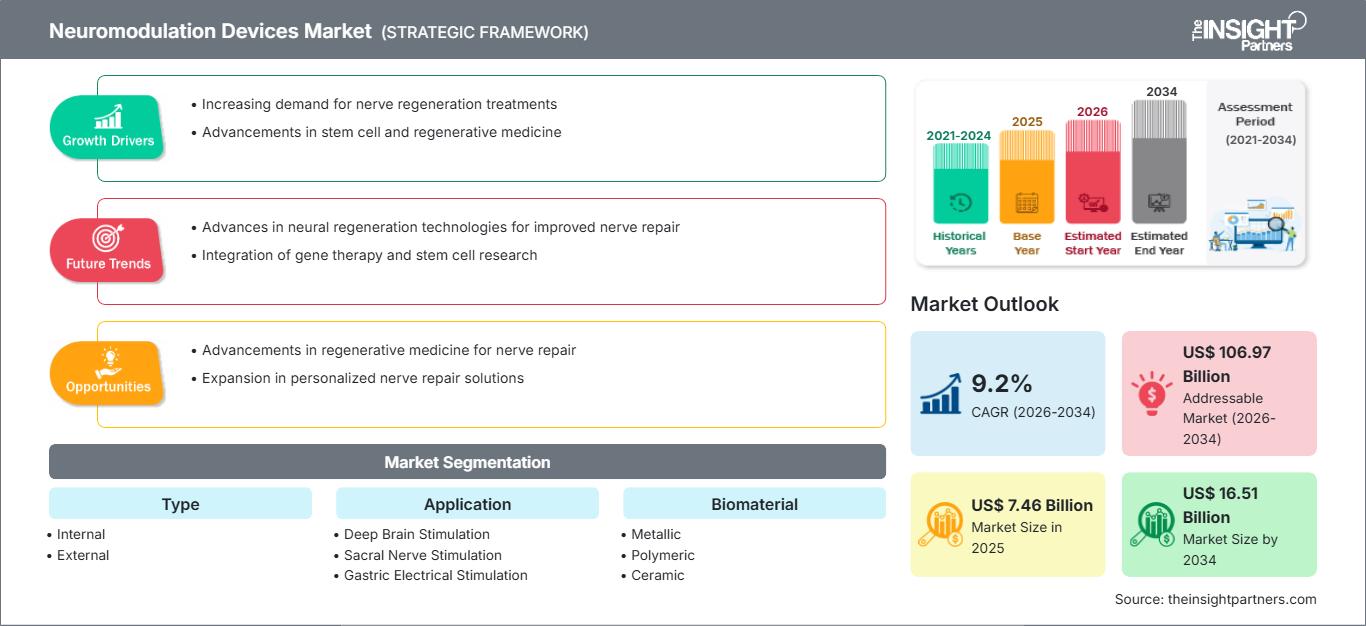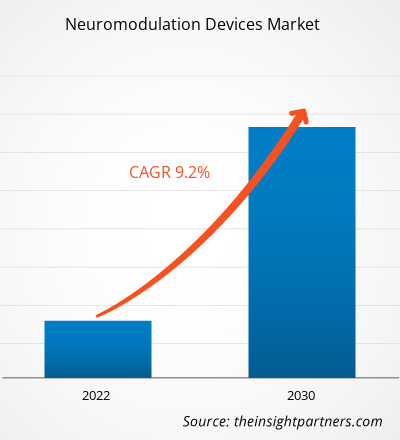ニューロモジュレーションデバイス市場は、2025年に74億6,000万米ドルと評価され、2034年には165億1,000万米ドルに達すると予測されています。2026年から2034年にかけて年平均成長率(CAGR)9.2%で拡大し、市場は継続的に変化しており、ステークホルダーにとって新たな機会が生まれています。市場全体の見通しは、安定した成長と長期的な成長の可能性を反映しています。
ニューロモジュレーションの使用は急速に増加しており、神経精神疾患および神経疾患の治療には、幅広い埋め込み型および非侵襲性の技術ベースの方法が採用されています。頭蓋内皮質刺激(ICS)、経頭蓋磁気刺激(TMS)、脳深部刺激(DBS)、経頭蓋直流刺激(tDCS)などの治療法は、さまざまな神経精神疾患および神経疾患において有望な結果を示しています。ニューロモジュレーション装置は、神経系の活動を調整できる高度な医療機器です。この技術は、ジストニア、パーキンソン病、振戦、耳鳴り、強迫性障害、感覚障害、てんかん、膀胱コントロール、頭痛、慢性疼痛、脳卒中、最小意識状態、痙縮、脊髄損傷などの運動障害の治療に使用されています。脊髄損傷症例の増加や神経疾患の有病率の増加などの要因が、ニューロモジュレーション装置市場規模の拡大に貢献しています。
市場の推進要因:
高齢者は神経疾患にかかりやすい傾向があります。高齢者によく見られる神経疾患には、神経障害、パーキンソン病、アルツハイマー病、ジストニアなどがあります。国連経済社会局によると、2022年時点で世界の65歳以上の人口は7億7,100万人でした。高齢者人口は2034年までに9億9,400万人、2050年までに16億人に達すると予想されています。米国やカナダなどの国では、高齢化に伴い、運動障害や精神疾患の有病率が高くなっています。パーキンソン病財団によると、パーキンソン病の症状は平均60歳でよく見られます。
カナダ心理学会によると、カナダでは強迫性障害(OCD)が人口の約2%に影響を与えています。世界保健機関(WHO)は、てんかんは発作を引き起こす神経疾患であり、世界中で約5,000万人が罹患していると述べています。米国神経学会によると、米国では脳卒中が第3位の死因であり、次いでアルツハイマー病が第6位となっています。同じ統計によると、約100万人のアメリカ人がパーキンソン病を患っており、毎年少なくとも6万人の新規症例が報告されています。神経疾患の罹患率の増加と、うつ病や慢性疼痛などの生活習慣病が相まって、先端技術を駆使した製品の採用が増加しています。
したがって、神経疾患にかかりやすい高齢者人口の増加、疾患の有病率の上昇、および神経障害の多大な負担に関する意識の高まりが、神経調節デバイス市場の成長を促進します。
神経科学は、脳卒中、頭痛、多発性硬化症などの重篤な疾患の治療に重点を置いています。近年、先進国においても熟練した神経内科医の相対的な不足が顕著になっています。米国には5,700以上の病院がありますが、これらの病院に勤務する脳神経外科医は3,700人未満です。脳神経外科医の不足の主な要因は、十分な訓練を受けた脳神経外科医を適切な期間内に育成できないことです。都市部には高度な技術を備えた神経学施設がありますが、地方では専門家の不足により、提供される治療は限られています。そのため、熟練した脳神経外科医の不足は、神経調節デバイス市場の成長を阻害しています。
要件に合わせてレポートをカスタマイズ
このレポートの一部、国レベルの分析、Excelデータパックなど、あらゆるレポートを無料でカスタマイズできます。また、スタートアップや大学向けのお得なオファーや割引もご利用いただけます。
ニューロモジュレーションデバイス市場:戦略的洞察

-
このレポートの主要な市場動向を入手してください。この無料サンプルには、市場動向から見積もりや予測に至るまでのデータ分析が含まれます。
レポートのセグメントと範囲:
「神経調節デバイス市場分析」は、タイプ、アプリケーション、生体材料、エンドユーザーなどのセグメントを考慮して実施されました。
セグメント分析:
ニューロモジュレーションデバイス市場は、タイプ別に外用と内用に分かれています。2022年には、内用ニューロモジュレーションデバイス市場において内用セグメントが大きなシェアを占めました。しかし、2022年から2030年にかけては、外用ニューロモジュレーションセグメントの方が高いCAGRを記録すると予想されます。「内用ニューロモジュレーション」とは、特定の神経標的に電気的、化学的、またはその他の形態の刺激を与え、神経系の活動を調節または変化させる医療機器の使用を指します。この技術は、神経血管疾患、運動異常、てんかん、慢性疼痛、便失禁・尿失禁などの治療に用いられます。
エンドユーザー別に見ると、ニューロモジュレーションデバイス市場は、病院、診療所、在宅医療に分類されます。2022年には、病院セグメントがニューロモジュレーションデバイス市場シェアの大部分を占めました。多くの病院や診療所の拡大と、医療インフラ整備への政府支出の増加により、現在、病院セグメントが市場を支配しています。さらに、高齢化に伴い慢性疼痛の有病率が上昇すると予想されており、病院におけるニューロモジュレーションデバイスの需要が高まっています。
地域分析:
ニューロモジュレーションデバイス市場レポートの範囲は、主に北米(米国、カナダ、メキシコ)、欧州(スペイン、英国、ドイツ、フランス、イタリア、その他の欧州)、アジア太平洋(韓国、中国、インド、日本、オーストラリア、その他のアジア太平洋)、中東およびアフリカ(南アフリカ、サウジアラビア、UAE、その他の中東およびアフリカ)、南米および中米(ブラジル、アルゼンチン、その他の南米および中米)に区分されています。
収益の面では、北米が2022年に神経調節デバイスの市場シェアを独占しました。神経疾患の罹患率の増加、研究開発費の高騰、FDAによる製品承認数の増加、技術の進歩により、この地域における神経調節デバイスの需要が高まっています。
神経調節デバイス
ニューロモジュレーションデバイス市場の地域別分析
予測期間全体を通してニューロモジュレーションデバイス市場に影響を与える地域的なトレンドと要因は、The Insight Partnersのアナリストによって徹底的に解説されています。このセクションでは、北米、ヨーロッパ、アジア太平洋、中東・アフリカ、中南米におけるニューロモジュレーションデバイス市場のセグメントと地域についても解説します。
ニューロモジュレーションデバイス市場レポートの範囲
| レポート属性 | 詳細 |
|---|---|
| 2025年の市場規模 | 74億6000万米ドル |
| 2034年までの市場規模 | 165億1000万米ドル |
| 世界のCAGR(2026年~2034年) | 9.2% |
| 履歴データ | 2021-2024 |
| 予測期間 | 2026~2034年 |
| 対象セグメント |
タイプ別
|
| 対象地域と国 |
北米
|
| 市場リーダーと主要企業の概要 |
|
神経調節デバイス市場のプレーヤー密度:ビジネスダイナミクスへの影響を理解する
ニューロモジュレーションデバイス市場は、消費者の嗜好の変化、技術の進歩、製品の利点に対する認知度の高まりといった要因によるエンドユーザーの需要増加に牽引され、急速に成長しています。需要の増加に伴い、企業は製品ラインナップの拡充、消費者ニーズへの対応のためのイノベーション、そして新たなトレンドの活用を進めており、これが市場の成長をさらに加速させています。

- 神経調節デバイス市場のトップキープレーヤーの概要を入手
競争環境と主要企業:
ニューロモジュレーションデバイス市場レポートは、アボット(セント・ジュード・メディカル社)、LivaNova PLC、ボストン・サイエンティフィック・コーポレーション、Aleva Neurotherapeutics SA、Bioventus、EnteroMedics Inc、Nevro Corporation、NeuroPace Inc、Synapse Biomedical Inc、Neurosigma Incといった市場の主要企業に焦点を当てています。ニューロモジュレーションデバイス市場予測は、ステークホルダーが成長戦略を策定する上で役立ちます。これらの企業は、世界中で高まる消費者需要に対応するため、新技術の導入、既存製品のアップグレード、市場拡大に注力しています。各社のプレスリリースによると、最近の主要な動向は以下のとおりです。
- 2023年8月、メドトロニック社は、閉ループ式充電式脊髄刺激装置(SCS)「Inceptiv」のCEマーク認証を取得しました。本製品は、メドトロニック社製SCSデバイスとして初めて、一人ひとりの生体信号を感知し、必要に応じて刺激を刻々と調整することで、日常生活の動作と調和した治療を実現する閉ループ機能を搭載しています。
- 2023年8月、アボットはFlexBurst360療法を搭載した新型脊髄刺激装置Proclaim Plusについて、米国食品医薬品局(FDA)の承認を取得しました。アボット独自のBurstDR刺激装置の次世代であるFlexBurst360療法は、体幹および四肢の6つの領域にわたる疼痛領域をカバーします。これにより、個々の治療ニーズに合わせて調整可能なプログラミングが可能になります。
- 過去2年間の分析、基準年、CAGRによる予測(7年間)
- PEST分析とSWOT分析
- 市場規模価値/数量 - 世界、地域、国
- 業界と競争環境
- Excel データセット
最新レポート
お客様の声
購入理由
- 情報に基づいた意思決定
- 市場動向の理解
- 競合分析
- 顧客インサイト
- 市場予測
- リスク軽減
- 戦略計画
- 投資の正当性
- 新興市場の特定
- マーケティング戦略の強化
- 業務効率の向上
- 規制動向への対応






















 無料サンプルを入手 - 神経調節デバイス市場
無料サンプルを入手 - 神経調節デバイス市場